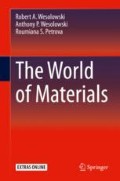Abstract
There are various ways to illustrate how composites are stronger materials than the components parts of the composite. Using a piece of Styrofoam, approximately 12″ × 1″ × 1/2″, have a volunteer place the material over their head, and begin to bend the material ever so slowly. The Styrofoam material will eventually break, showing little ability of restraining the force being applied. Take a send piece of Styrofoam of similar dimensions. Apply a strip of duct on one side of Styrofoam thereby making a composite material. With the “duct” tape on the top, have the volunteer repeat the bending procedure. The composite Styrofoam will bend but not break. The composite material has a new and different characteristic; it can withstand the force applied and is therefore stronger than the original material. What happens when the composite Styrofoam has the duct tape on the bottom? When the volunteer places the composite Styrofoam over their head and applies a force as done in the past, will the material created withstand the force or not? What would occur if a new piece of Styrofoam of similar dimensions has a piece of duct tape wrapped entirely around the Styrofoam and a similar force is applied as in the previous two cases? The tape and Styrofoam system is a form of lamination. “Lamination is the technique of manufacturing a material in multiple layers, so that the composite material achieves improved strength, stability, sound insulation, appearance or other properties from the use of differing materials. A laminate is usually permanently assembled by heat, pressure, welding, or adhesives” (Lamination 2015).
Theory is great, but theory does not beat getting your hands dirty. Tests can be conducted determining the strength of the product made. A “three-point test” is a simple test where the product is permitted to reach its maximum stress point. Investigating the deflection point is another test used in industry to measure flexibility. Creating the structure of the material, its appearance, so that it can be tested is also critical. To use the three-point test, a beam must be created. It may be important to create a cylinder to use a compression test. Here is where making and testing composites becomes enjoyable.
Access this chapter
Tax calculation will be finalised at checkout
Purchases are for personal use only
Reference
Lamination. (2015). Wikipedia, Carter, Richard. Method of laminating multiple layers. Google Patents. Retrieved 15 February 2015.
Author information
Authors and Affiliations
Rights and permissions
Copyright information
© 2020 Springer Nature Switzerland AG
About this chapter
Cite this chapter
Wesolowski, R.A., Wesolowski, A.P., Petrova, R.S. (2020). Making and Testing Composites. In: The World of Materials. Springer, Cham. https://doi.org/10.1007/978-3-030-17847-5_17
Download citation
DOI: https://doi.org/10.1007/978-3-030-17847-5_17
Published:
Publisher Name: Springer, Cham
Print ISBN: 978-3-030-17846-8
Online ISBN: 978-3-030-17847-5
eBook Packages: Chemistry and Materials ScienceChemistry and Material Science (R0)

